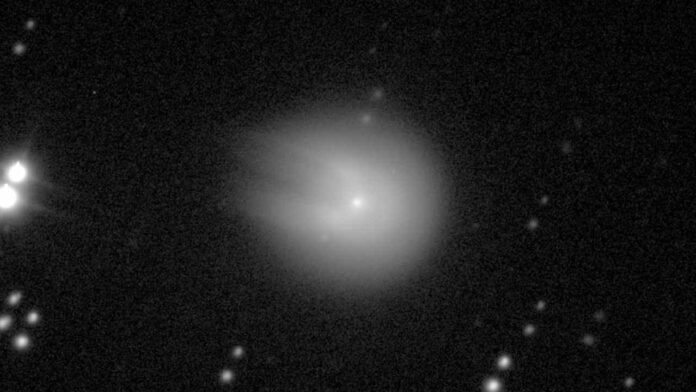Comet 12P/Pons-Brooks is a spectacular and rare sight in the sky. It is a cryovolcanic comet, which means that the sun can cause its solid core of ice, dust, and gas to burst. The core is about 30 kilometres (18.6 miles) across, and it is surrounded by a fuzzy cloud of gas called a coma.
The comet has erupted twice in the last four months, on July 20 and October 5, 2023. Each time, the comet became much brighter, and its coma became larger and more irregular. The coma developed two horn-like features that some observers compared to a sci-fi spaceship, such as the Millennium Falcon from Star Wars.
A notch on the comet’s core that prevents some of the gas from escaping from the inside is probably what causes the horns. As the gas expands outward, it forms a distinctive shape that changes as the comet rotates.
The comet is on a long and elliptical orbit around the sun that takes 71 years to complete. It is now approaching the inner solar system, where it will swing around the sun in April 2024. It will come closest to Earth in June 2024, when it might be visible to the naked eye in dark skies. After that, it will head back to the outer solar system and not return until 2095.
The comet is known for its unpredictable outbursts, which make it one of the brightest periodic comets. Chinese astronomers first observed it in the 1300s, and Jean-Louis Pons and William Robert Brooks gave it its name in the 1800s.
The comet will share the sky with a total solar eclipse on April 8, 2024. That means the darkened sun and comet will be close together in the sky. However, scanning with optical aids near the sun is very risky and should be left to experienced observers.
Where is Comet Pons-Brooks now?
Comet Pons-Brooks is currently in the constellation of Hercules. It is not far from the bright globular cluster M92. The moon will not interfere with its observation until around October 21st.
The comet is not alone in its volcanic activity. Another comet, 29P/Schwassmann-Wachmann (29P), is also very active and has had several eruptions in the last year. In December 2022, it had its biggest eruption in 12 years, spewing out about 1 million tonnes of icy material. In April 2023, scientists were able to predict one of its eruptions for the first time based on a slight increase in its brightness before the event.
These comets are fascinating objects that reveal the diversity and dynamism of our solar system. They also offer a glimpse into the past, as they contain ancient material from the formation of the planets.
